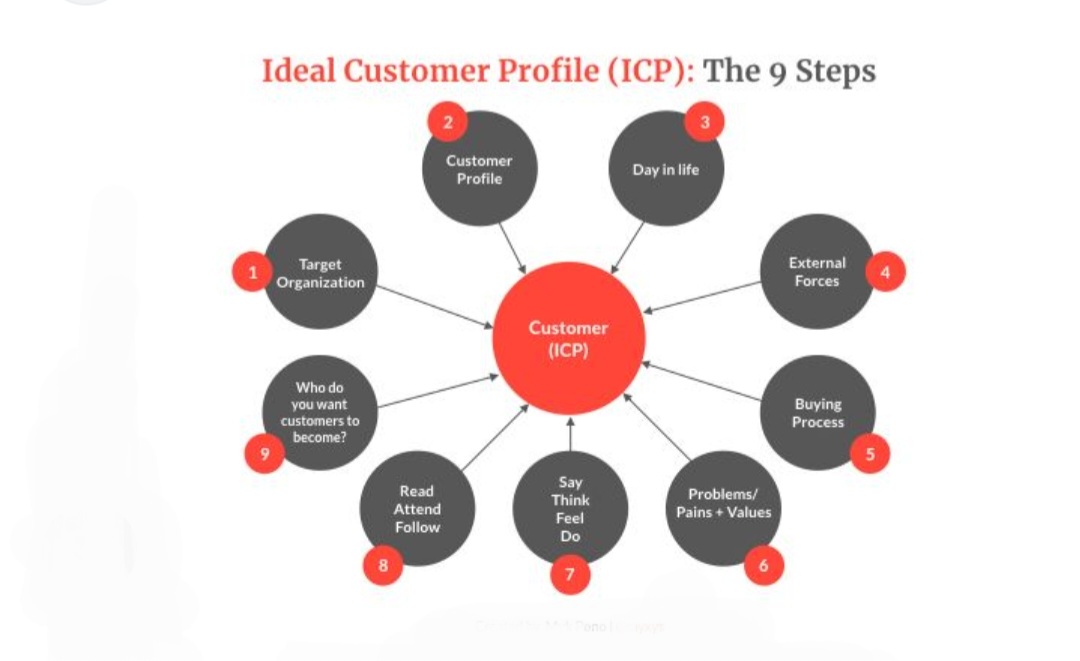
NOTES
Ideal Company Profile
The ldeal Customer Profile (1CP) is the type of company that would benefit that most from your
product or solution. The ICP is defined using firmographics, such as technographic data,
company size, revenue, industry, and location.
To find your ICP, first determine a list of your most successful customers. Then, identify the
characteristics, or firmographic data, that they have in common by comprehensively gathering
key facts and data that describe your customer base. Here are some key firmographics to get
you started:
- Industry -A group of companies that offer similar types of goods or services.
- Revenue -A company’s annual income; your ICP will likely have a revenue range.
- Technographic Data – The tools and technologies that a company purchases and uses.
- # of Employees – The number of employees in the company or specific department.
Not every firmographic is created equal. To start off, we’ve selected the most important
attributes, based on our research, that you want your target accounts to have. You can always
add or subtract criteria to narrow or broaden your list as needed.
ldeal Contact Profile
Next, after defining the ldeal Customer Profile, we will identify the ldeal Contact Profile by empirically describing the contact(s) involved in the decision-making process. Most enterprise
deals have an average of 5 contacts involved before a decision is made.
Based on your experiences, what are the keywords and titles associated with the most
appropriate people to speak with at a company meeting the criteria of the ideal company
profile?
As a follow-up, we will organize the titles into personas. We define the personas by identifying
the characteristics and keywords/titles they have in common and aligning them to those
personas. Here are some key characteristics to get you started:
- Titles
- Pain Points & Challenges
- Demographics
Again, these personas will serve as an excellent starting point for our future list segmentations
and campaigns to which we will align specific messaging and value propositions for highly
effective engagement.
Example: the economic buyer, the end-use, and the technical buyer.
The economic buyer is most interested in the impact the challenge the end user
experiences has on the business– are the economic consequences sufficient to make
any reasonable economic buyer anxious to fix the problem? What are the costs avoided?
The economic buyer must be presented with a compelling reason to buy.
The end user is the individual experiencing the challenge, and pain and frustration. Your
technology will allow them to address that challenge/task in a different, more efficient
way. The new approach will enable them to get unstuck and be more productive. They
should know how they go about the task without your product, we help them understand
how they will go about that task with your product.
The technical buyer needs to understand the challenge (believe it or not, they may not be
aware), what goes wrong, and how and why it goes wrong. They need to know what the
end user is trying to accomplish, why it’s important, and the business results.
Please note, in smaller organizations one individual may represent multiple roles.
Level & Function
Level:
- CLevel
- Vice President
- Director
- Manager
- Staff
- Other
Function:
- IT
- Security
- Legal
- Sales
- Marketing
- HR
- Finance
Closed Won Analysis
(or Design Partner)
Next, We will identify the prominent keywords and titles associated with your open opportunities and closed-won accounts as well as segment those accounts by firmographics to identify trends and understand where we have seen success in the past.
Industries
- TBD
Annual Revenue
- TBD
Employee #
- TBD
Technographics
- TBD
Contact Keywords & Titles
- TBD
TAM Analysis
Based on the parameters detailed above, the total addressable market is as follows:
Segmentation. Accounts. Records
ALL (General) # #
TBD. # #
TBD. # #
TBD. # #
TBD. # #
TBD. # #
Suppression List
“Company Does NOT Contain” – To avoid any potential conflict, it is important that we develop and maintain a Suppression List of all your competitors, accounts with open opportunities, closed-won accounts, and any other companies we do not want to engage.
“Title Does NOT Contain” – To maintain efficiency and remove the clearly incorrect contacts, it is mportant that we develop and maintain a Suppression List of all the keywords and titles we do
not wat to engage.
Common Examples:
- Business Development
- Sales
- Marketing
- Consumer
- Labor
- Process Innovation
- Water
- Linux
- Storage Tank
- Finance/Financial
- Intern
- Unix
- Employee Benefits
- Junior
- Lease
- Business Relationship
- Workers Compensation
- Safety
- QA/Quality Assurance
- Commercial
- Real Estate
- Lending
- Billing
- Health Plan
- Junior
- Order Management
- Systems Administrator
- Analyst
- Database Administrator
- Pipeline
- Administrative Assistant
- Professor
- Student




